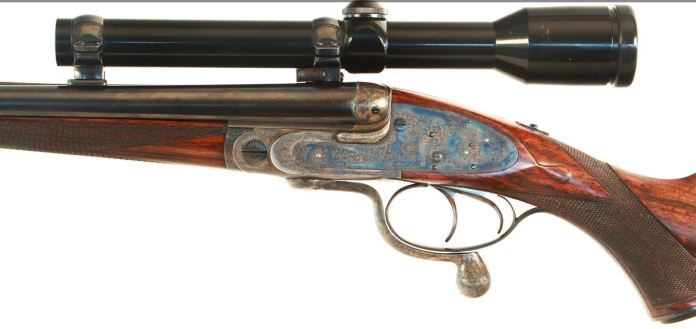
A 9.3x74R double rifle by Purdey. Photo (c) Joh. Springer’s Erben
Post-modernism anticipated. Even though James Purdey pioneered the two-groove stalking rifle, and even is said to have coined the term “Express”, breech-loading double rifles by J. Purdey & Sons are extremely rare. Even fewer of them are built on the house’s trademark Beesley’s patent self-opening action – but what makes this 1898 Purdey double rifle doubly special is that it is used in combination with Jones underlever loclup.
The Beesley patent (see more on it in this story by Igor Karklinsh) is considered by some to be the finest side-by-side action ever. I used to crave for one when I was a gun-crazed kid, and strangely enough what sold me on it most was the promise that the mainsprings are always released when the gun is taken apart, saving their wear. I know, I know, but that’s how the Soviet gun writer that I’d read had it. I have my doubts now whether its legendary status owes more to exclusivity than to mechanical and operational merit, but you can’t deny that back in the 1890s it was indeed the most advanced action.

The same Purdey shown from below. Photo (c) Joh. Springer’s Erben
But why would Purdey’s decide to mate it with Jones underlever, the oldest surviving lockup system of the era?
I don’t mean that Jones underlever is bad. It’s a very simple system – there’s literally nothing that can possibly go wrong; and it’s very strong, with the bolt and the lugs forming a screw that presses the barrels to the action. This also provides a sort of self-regulatory feature – as the surfaces wear out, the bolt goes in deeper, and keeps the lockup tight. Last but not the least, a hammer gun with non-snap-action Jones underlever can be operated without any sound whatsoever – a great advantage to one who’s intimately proximate to an angry wounded rhinoceros that needs but a low-key metallic click to identify the location of that obnoxious firestick-toting monkey. Safari writers of the late XIX century sang a chorus of praises for Jones underlever for this very reason.

The rotary bolt – and the characteristic cams and pushrods of Beesley’s patent. Photo (c) Dogs and Doubles
But coupling it with Beesley patent hammerless action makes very little sense. It would have to be a snap action – I can’s see a Beesley patent, that cocks on the closing of the barrels, paired with a lockup that would not automatically snap in place, although a creature with three arms wouldn’t find it too objectionable. A big underlever, powered by a substantial spring, would make almost as much noise as a bolt action – and it’s not as convenient as the now-traditional lop lever anyway.

Another interesting feature of Beesley/Jones Purdey DRs is the little lever that blocks the safety in the off position. Photo (c) Dogs and Doubles.
When I first saw such a rifle, a .303 made circa 1895, on the Dogs and Doubles web site (there’s a video of its operation and a comparison with a Holland&Holland from the same time span) I thought it was a one-off. Then I saw another one in the Joh. Springer’s Erben auction catalogue – and even wondered if it wasn’t the same rifle. But no, the one from the auction was a 9.3x74R and dated 1898. And Gregg writes me there’s another one – click here to look at it – also a .303, 1897 built. That makes at least three nearly identical double rifles, completed across three years – it means that the combination wasn’t a whim of an individual, but something Purdey’s actually believed in, even though for a while.

I bet this top bite could do the duty alone. Photo (c) Dogs and Doubles.
Strength, perhaps, is the answer. You see that at least one of those rifles comes with a substantial top fastener – obviously going overboard, as the traditional Jones underlever was strong enough to do its duty alone even on 8-bore and 4-bore rifles. But in the late 1890s, the nitro powder rifle cartridges were still a new thing. As far as I know, some of the very first attempts to build double rifles for them underestimated the pressure they developed, resulting in burst barrels and broken actions. It could be that Purdey’s decided not to take risks and create the strongest lockup they possibly could. The wall thickness of the .303 on the above pic also looks somewhat excessive.
Whatever the rationalle behind it, the combination of Purdey Jones/Beesley double rifles makes for a very original, if postmodernist, design.

Great article and some of the finest doubles ever made, Makes me long to be young again.
LikeLiked by 1 person